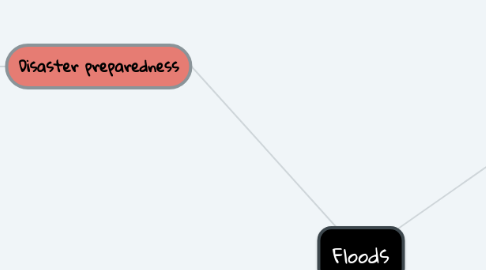
1. Disaster preparedness
1.1. Taking further spaces to reduce the harm caused by floods
1.1.1. Forecasting and warning system
1.1.1.1. Water levels, tide levels and weather are monitored, with professionals analysing data and forecasting the area which are likely to be flooded (warnings would be sent out the public via radio, news and apps)
1.1.1.2. Pros
1.1.1.2.1. Provide important information for people to take action to minimise damage
1.1.1.3. Cons
1.1.1.3.1. Cities may not have the expense and technology to collect accurate data and may cause false alarms
1.1.2. Evacuation drills
1.1.2.1. A form of preparedness measure by having people practising the steps to take to leave a affected place for a safer place in an orderly manner
1.1.2.2. Pros
1.1.2.2.1. Educate people on safety measures
1.1.2.2.2. Mentally prepare people so that they know how to react in times of emergency
1.1.2.2.3. Evacuation drills help cities to improve their flood evacuation plan
1.1.2.3. Cons
1.1.2.3.1. Effectiveness is largely dependent on the willingness of participants
2. Regulation
2.1. A rule or a law which is enforced by an authority and which states how something should be done
2.1.1. Zoning
2.1.1.1. A way in which the government plans the physical development of the land and its uses by dividing the area into smaller zones and determining whether the area can be used for high valued (away from areas with high risks) or low valued (nearest to areas with highest risks) developments
2.1.1.1.1. Eagan City in Minnesota, USA has areas near the Minnesota river which are flood prone and used for low value developments like the Minnesota Valley National Wildlife Refuge and parks.
2.1.1.1.2. City of cologne has zoning where buildings away from the river
2.1.1.2. Pros
2.1.1.2.1. Creates green spaces such as parks and fields which help to reduce the impact of flood damage
2.1.1.2.2. Reduce loss from flooding
2.1.1.3. Cons
2.1.1.3.1. Limit development of available land as only certain land uses are permitted
2.1.1.3.2. Difficult to carry out due to competing land uses and people may not abide by recommended land use
2.1.2. Elevated properties
2.1.2.1. Raising properties to a certain height according to minimum platform level (MPL) which is determined by flood history
2.1.2.2. Pros
2.1.2.2.1. Development is protected against floods up to the height of MPL
2.1.2.3. Cons
2.1.2.3.1. Challenging due to increased cost of development
3. Investment in infrastrature
3.1. Cities invest in infrastructure to reduce the impacts of floods. Besides building new infrastructure, there is also a need to maintain existing infrastructure to ensure they are all in working condition
3.1.1. Levees and flood walls
3.1.1.1. Building barriers that are higher than flood plains rivers or canals
3.1.1.2. Pros
3.1.1.2.1. Cheaper than elevating properties
3.1.1.3. Cons
3.1.1.3.1. Regular maintenance required
3.1.1.3.2. Can only hold back floodwater at a certain level
3.1.2. Chanel improvement
3.1.2.1. Increasing capacity or the speed of flow through widening, deepening or straightening of drains, canals and rivers which can prevent overflow
3.1.2.2. Pros
3.1.2.2.1. Possible to have moderate value and high value developments to take place on the land adjacent to river channels and canals
3.1.2.3. Cons
3.1.2.3.1. Difficult to carry out due to existing development
3.1.2.3.2. Might cause problems for areas upstream or downstream of the improved area
